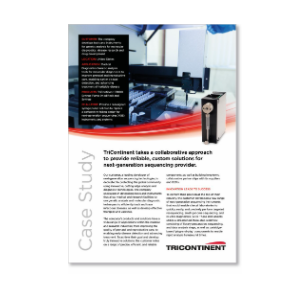How can we help you?
How can we help you?
TriContinent provides a wide range of various syringe pump modules known for their long-lasting and exceptional quality. These pumps are designed for precision and accuracy and provide a combination of stable, low flow, and low pulsation. These design features are of particular interest for various liquid handling applications, including (In Vitro Diagnostics) IVD.
TriContinent offers a seamless replacement for industry standard syringe pumps using the Cavro® protocol. We provide syringe pump for OEM laboratory instruments that have the highest accuracy and precision: the C-Series and CX-Series . We also offer affordable solutions for all standard dispensing tasks: the AccuPump and BasePump. The available syringe sizes range from 50 µl up to 12.5 ml (C-Series and CX-Series).
Our syringe pump modules offer the following features for your application and instruments:
TriContinent syringe pumps are ideal for next generation sequencing (NGS), lab automation, life science, and IVD instrument manufacturers. These manufacturers are looking to maximize the investments in their existing instrumentation.
All our syringe pumps utilize standard communication protocols and mounting configurations used by other compact syringe pump designs. By using industry standard communication protocols we have eliminated expensive and time-consuming redevelopment.
At TriContinent, we customize our products to the exact requirements of our client’s application. We have a long and successful history of providing application specific custom OEM liquid handling products for our customers. These products vary from simple modifications of standard syringe pumps to liquid handling (XYZ) robots.
We also provide completely custom designed syringe pumps and accessories. These pumps have proven superior durability to reduce service costs and field failures in our customer’s existing instruments.
A leading developer of next generation sequencing (NGS) technologies turned to TriContinent syringe pumps to help them evolve their equipment. With tricontinent pumps they were able to perform precise targeted resequencing, small-genome sequencing, and in-vitro diagnostics (IVD). The company’s goal was to incorporate a high-precision syringe pump with high accuracy and a low risk of carryover. We successfully accomplished this with a range of improvements. Read our case study to see how our modified C3000 unit provided exactly what the customer was seeking.

We offer Rotary Shear Valves that are well-known in the industry for their unsurpassed long lifetime and reliability. By using our rotary valves, your instrument will benefit from longer up-time, lower service costs, and increased customer satisfaction.
Our syringe pump liquid handling module can accomplish many aspiration and dispensing operations. The stepper motor-driven syringe pump accurately and precisely handles fluids using various volumes. These syringe volumes range from a few microliters to 12.5 milliliters. The syringe drive arm can be easily back driven in our C3000 or CX6000, making syringe installation or replacement extremely quick and easy.
TriContinent’s syringe pumps work by filling a syringe with fluid and emptying the syringe through an alternate flow path. The syringe pump consists of three components: a syringe, a drive mechanism and a rotary shear valve. The simplest configuration of a pump is a 3-port valve where one port is connected with the syringe. In this configuration, one of the other ports acts as the inlet and the third port serves as the outlet port.
What does the workflow look like?
1. The plunger moves up and the syringe is emptied – the system is now at its starting point.
2. The valve switches to the inlet position.
3. The plunger moves down and the syringe is filled with medium (aspiration).
4. Then the valve switches to the outlet position
5. The plunger moves up and the syringe dispenses the desired volumes The process repeats until the syringe is completely empty. Once done, the syringe pump can start aspiration of the new medium.